Introduction
As a replacement for the Chieftain, the Challenger arrived almost as an accident. Although it was planned already in the 1970s, the Export versions of the Chieftain really gave the impetus to develop the new main battle tank, not in all directions as the main armament and protection of the latter was unsurpassed at the time, but in the field of mobility, which was indeed its main critic. Iran noticeably, prior to the 1979 revolution acquired the Chieftain and was quite happy with it, but ordered a mobility improvement which gave birth to the 4030/3 Shir 2 by Military Vehicles and Engineering Establishment (MVEE) near Chobham in Surrey. It also came with a brand new armor package which was even far superior. After the fall of the Shah and the order cancellation, all this development work was passed into the Cheviot, later known in the final phase, the Challenger, in remembrance of the ww2, 17-pdr armed first version. The Challenger was replaced in 1990 by the all-improved Challenger 2, and both tanks were largely battle-tested in Iraq and Afghanistan.Development: From the Shir to the Challenger.
In 1977, an Iranian order for an improved version of the Chieftain came out. After the MVEE created the Chieftain Mark 5(P), giving birth to three prototypes, also known as the FV4030/1, the FV4030/2 Shir (Lion) 1 (in service with the Jordanian Army), and later the 4030/3 Shir 2. The Shir 1 (ordered by Jordan) possessed an improved running gear that will turn to be the one designed for the Challenger 1. It was also a transition vehicle to the Shir 2. The latter was canceled after the fall of the Shah in 1979, but the project came out as a new design after reworking at ROF Leeds. The chassis front half came from the Chieftain, the running gear and rear section from the 4030/2 Chassis Shir 1. The roomier compartment allowed to fit a much more powerful Rolls-Royce CV12 engine producing 1200 bhp at 2,300 rpm. Among other modifications proper to the Shir 2 were the removal of the searchlight (left turret), refitting of the storage baskets, removal of the driver's hatch water channel, the glacis plate light clusters were modified and the sight housing on the commander's cupola was enlarged. The final design was sanctioned at the Royal Ordnance Factories (ROF). After being re-christened Cheviot and then Challenger, the new MBT was accepted and entered service with the British Army in 1983. Production ceased in 1989. The Challenger I was kept in service until 2001 (ported at the Mk.4 standard), when it was replaced by the Challenger 2, which only shared 5% of common parts with the Challenger 1.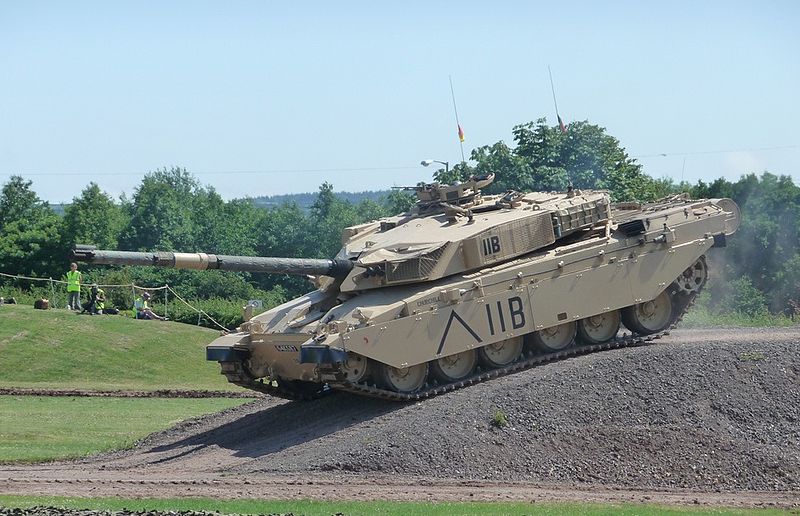
Design of the Challenger
The crew comprised the driver, seated in a well reclined position, located in the center of the very shallow hull, forward of the turret ring, with its own forward-folding hatch fitted with three observation periscopes and central sight that can be swapped for a Pilkington Optronics Badger passive periscope for night driving, while the three other members of the crew are located in the turret. The gunner is installed in the front-right, with the commander right behind while the loader is seated on the left, with ready round ammunitions and access to the turret bustle rounds storages. The commander has an excellent peripheral view thanks to the nine vision blocks of its No 32 cupola. He had a day sight that could be replaced quickly by a Rank Pullin image intensification swap sight. This provided excellent day/night magnification and there is a cupola ring for holding an optional LMG mount. Hunter-Killer mode is standard thanks to the TOGS system (Thermal Observation and Gunnery Sight) by separating the target output. The latter was manufactured by Barr & Stroud and Avimo. The gunner is in charge of the main targeting sight, fitted with IR day/night magnification and Nd:YAG laser FCS which range is 11,000 yards (10,060 m). Observed accuracy is in the range of 10 m for 90% of shots at 10,000 m. The gunner also has a backup, the emergency No 87 periscopic sight normally hidden under armor and collimated with the gun. The loader have a roof-mounted x1 periscope swivel-mounted forward of his two-piece hatch cover.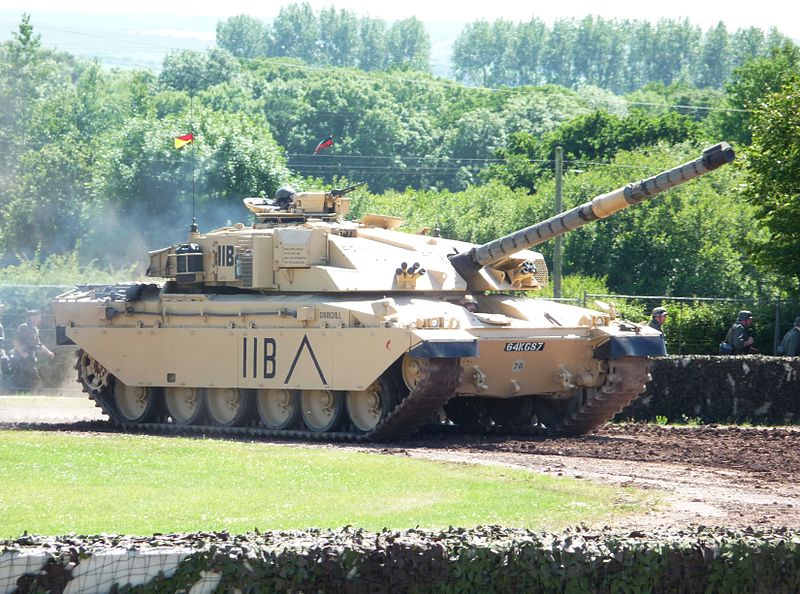
Protection
The turret is almost perpendicular in shape, with a well-sloped front and low profile walls. Additional storage is provided at the back and rear sides. There are provisions at the back of the hull for extra fuel drums. The crew is protected by a collective NBC with a pressured compartment and slight overpressure system. There are automatic fire extinguisher systems in the turret and engine compartments. The ROF and MVEE team resulted in other modifications. The level of protection was raised even further with the adoption of the new Chobham armour, which composition remains highly classified (it is shared by the Abrams that inaugurated it). Speculations about its composition remains uncertain, but levels of soft and hard steel, kevlar, carbon, rubber and possible others polymers are sandwiched with Ceramic, which is the most important material. Its hardness and extreme heat resistance indeed helps defeat shaped charge jets (HEAT rounds), but also to shatter kinetic energy penetrators (KE-penetrators) as being abrasive. The shattering characteristics also creates extreme asymmetric pressures that disturbs the geometry of the jet, making it less effective. The interaction of ceramic with the metal jet also was compared to the effect of the explosive reactive armour. Both the Chobham and Chobham 2 (on the Challenger 2) were largely proven in combat, in the 1991 and 2003 gulf wars, Afghanistan and Iraq, proving both the Challenger and Abrams nearly impossible to destroy, or at least helping the crew survive many hits. This armor is mostly fitted on the turret, which shape is quite different than the Challenger's initial own RHA conception. But elements are found on the upper hull sides and glacis.Mobility
The engine compartment is home of the new Perkins Condor CV12 26 liter diesel 1,200 hp (895 kW) fitted with two Garrett-AiResearch turbochargers, to compare to the previous Chieftain's initial Leyland L60 multifuel 2-stroke opposed-piston giving 750 hp (560 kW) 6 Cylinders, 19 liters. The latter was 55 tonnes, while the Challenger is 62 tonnes, but the raw power almost doubled, allowing a much better power-to-weight ratio. Compared to other MBT which engine output is 1500 hp, but the powerplant can be changed in 45 minutes in the field and also have an auxiliary unit (APU). The engine is driven by a David Brown Defence Equipment Limited TN37 transmission. The torque converter is a Borg-Warner with lock-up clutch. The gearbox have four forward and three reverse gears, and steering is a Commercial Hydraulics STN37 double differential with hydrostatic and infinitely variable control.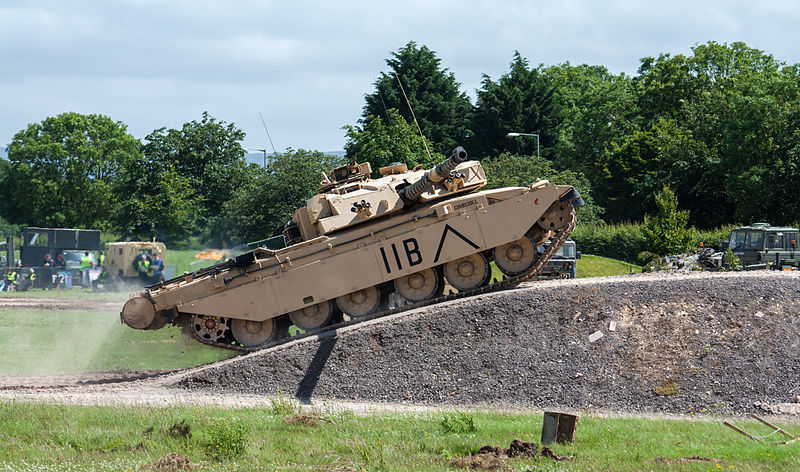 The powerplant was only part of the package, which came also with a brand new set of hydropneumatic (Hydrogas) suspension units designed by MVEE in conjunction with Air-Log Limited, and assembled by Vickers. The tracks are travelling with six aluminium roadwheels and two return rollers per sides.
This active system is much more advanced than the old Horstmann system used on the Chieftain and Centurion, allowing for greater weight and higher speed, at 56 kilometres per hour (35 mph) instead of 48 km/h (30 mph) on flat, but for the Chieftain this figure fall far beyond cross country which the hydrogas suspensions allowed to maintain an excellent off road cruise speed.
The drivetrain is protected, like the Chieftain, by conventional aluminium skirts. Field performances show this MBT could climb a gradient 58% high, stay stable on a side slope inclined to 40%, climb a vertical step of 0.9 m, cross a trench 2.8 m, and ford 1.07 m without preparation or 4-5 m with preparation (snorkel).
The powerplant was only part of the package, which came also with a brand new set of hydropneumatic (Hydrogas) suspension units designed by MVEE in conjunction with Air-Log Limited, and assembled by Vickers. The tracks are travelling with six aluminium roadwheels and two return rollers per sides.
This active system is much more advanced than the old Horstmann system used on the Chieftain and Centurion, allowing for greater weight and higher speed, at 56 kilometres per hour (35 mph) instead of 48 km/h (30 mph) on flat, but for the Chieftain this figure fall far beyond cross country which the hydrogas suspensions allowed to maintain an excellent off road cruise speed.
The drivetrain is protected, like the Chieftain, by conventional aluminium skirts. Field performances show this MBT could climb a gradient 58% high, stay stable on a side slope inclined to 40%, climb a vertical step of 0.9 m, cross a trench 2.8 m, and ford 1.07 m without preparation or 4-5 m with preparation (snorkel).
Firepower
The heart of the Challenger resides in its Royal Ordnance L11A5 120 mm rifled gun. This is the very same version used in the Chieftain, and a proven, accurate long range weapon which contrary to most contemporary main guns of the same caliber, is not smoothbore. This choice slightly reduce the range and velocity of the projectiles, but to the gain of a far greater accuracy. Other reasons given were that the slipping driving band allowed employment of a widest range of ammunition, and in general that a rifled barrel is more economical to produce and to maintain. It was conceived for ranges up to 2000 m, and saw eight production versions since its introduction in 1957.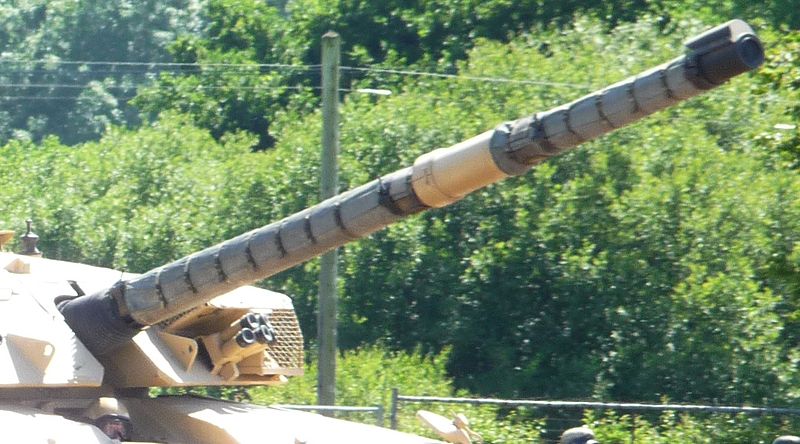 The A5 distinguished itself from previous versions by its integral muzzle reference system, smaller and lighter fume extractor (with a 7.7 kg balance weight to the breech). It will be replaced by the L30 on the Challenger 2. However the Challenger 1 will score the longest operational kill against another tank in history (4,000 m). Secondary armament comprised a coaxial 7.62 mm L8A2, and a roof-mounted (TC cupola) 7.62 mm L37A2 LMG, with 4,000 7.62 mm rounds in storage. The main gun was manually loaded, and the maximum rate of fire was around 10 rounds/minute in the best conditions, however 6/minute was more realistic in combat conditions, even with a trained crew. Normal elevation/depression was round +20/-10, more with the addition of the suspensions.
Maximum range (tested) was 3,000 metres (3,300 yd), at 4,495 ft/s (1,370 m/s) for an APDS and 8,000 metres (8,700 yd), 2,198 ft/s (670 m/s) for a HESH round. In action, the FCS proved able to engaged enemy target at a range of 5 100 m. In all, 64 (52 for other sources) separate loading type rounds were stored between the hull and turret. Ammunitions comprised:
The A5 distinguished itself from previous versions by its integral muzzle reference system, smaller and lighter fume extractor (with a 7.7 kg balance weight to the breech). It will be replaced by the L30 on the Challenger 2. However the Challenger 1 will score the longest operational kill against another tank in history (4,000 m). Secondary armament comprised a coaxial 7.62 mm L8A2, and a roof-mounted (TC cupola) 7.62 mm L37A2 LMG, with 4,000 7.62 mm rounds in storage. The main gun was manually loaded, and the maximum rate of fire was around 10 rounds/minute in the best conditions, however 6/minute was more realistic in combat conditions, even with a trained crew. Normal elevation/depression was round +20/-10, more with the addition of the suspensions.
Maximum range (tested) was 3,000 metres (3,300 yd), at 4,495 ft/s (1,370 m/s) for an APDS and 8,000 metres (8,700 yd), 2,198 ft/s (670 m/s) for a HESH round. In action, the FCS proved able to engaged enemy target at a range of 5 100 m. In all, 64 (52 for other sources) separate loading type rounds were stored between the hull and turret. Ammunitions comprised:
- L31 High Explosive Squash Head (HESH)
- L15 Armour Piercing Discarding Sabot-Tracer (APDS-T)
- L20 Discarding Sabot-Tracer (DS-T)
- L23 Armour Piercing Fin Stabilized Discarding Sabot (APFSDS)
- L34 Smoke round
- L32 Squash Head-Practice (SH-P)
- L35A1 canister shot
Variants
In addition to the gradual improvements from the Mk.1 to 3 the Challenger 1 Improvement Programme (CHIP) was launched to keep these upgraded until being shipped to Jordan and replaced by the Challenger 2. Not included here are the "tropicalized" versions applied to the Mk.2/3 which operated in the Middle East.- Challenger Mk1: First production version (March 1983), no TOGS. Sent in West Germany (five Rgts).
- Challenger Mk2: Equipped with TOGS.
- Challenger Mk3: Interior refined, some teething problems fixed.
- Challenger Mk4: Final production version and upgrade for all versions.
- Challenger Control/Command: Specialized versions with extra long range communication equipments.
- Challenger ARRV: Armoured Repair & Recovery Vehicle.
- Challenger Dozer (1990): Pearson Combat Dozer Blade (UDK1), or mine clearing systems.
- Challenger Training Tank (CTT)(1988): 17 were purpose-modified for £18 million. Turret replaced by a foxed superstructure for 2 instructors/4 students. Also compatible with maintenance training, still usable as ARV or dozer vehicle.
- Al Hussein: Jordanian version. Comprised desert modification like filters, new air conditioning.
- Challenger Marksman SPAAG twin 35 mm. Prototype fitted with the Marconi/Marksman turret which can be fitted on an unmodified chassis in 1h30.
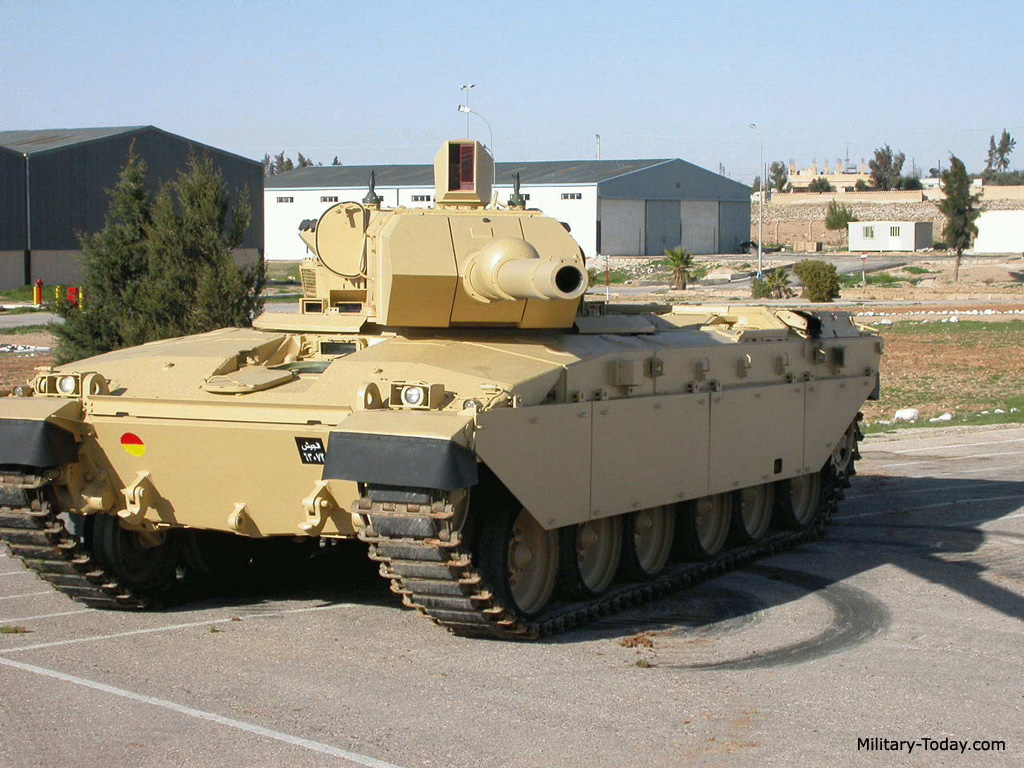 Al Hussein with the remotelly-operated Falcon turret. This 2010 upgrade is scheduled for all Jordanian Challengers in the next 15 years.
Al Hussein with the remotelly-operated Falcon turret. This 2010 upgrade is scheduled for all Jordanian Challengers in the next 15 years.
The Jordanian Challengers
The only operator outside UK was Jordan, that was interested in another batch of Shir to replace its Centurions (Tariq), eventually signed an order for 274 Challenger 1 tanks. However later, under a new agreement in March 1999, 288 surplus Challenger 1s were supplied in addition to Jordan over a three year period. In all, 104 were shipped for $105 million total signed in dec.2004 while 288 others were signed between june 1993 and dec. 2003 for $300.000.000 for an average cost of $765,306. Jordanian Challengers are know locally as the Al Hussein. The grand total was 392 Challenger 1, with several local variants. This left only 28 Challengers in service in UK, some for training, and ARVs. These Jordanian MBTs are now gradually upgraded to the Challenger 2 standard. Some were recently equipped with the unmanned narrow "Falcon Turret".The Challenger in action
CAT'87 competition (1987)
Before any engagement, in 1987, the ministry of defense wanted to showcase the Challenger in an international tank competition, the Canadian Army Trophy Competition (CAT'87), which was held at Grafenwöhr, West Germany this year. The newly-equipped 2nd Royal Tank Regiment was sent to participate with the even, which included gunnery markmanship exercises. Unfortunately, the 22 Challengers still not have been equipped with their Thermal Observation and Gunnery Sight (TOGS) and were literally picked up from the factory line, accumulating teething problems. Despite the skills of the crews, well trained with their BATUS Chieftains, the results were quite disappointing, triggering an official statement to never participate in the event any more.The gulf war (1991)
Fortunately for the supporters of the Challenger, Iraqi leader's decision to invade Kuwait raised an international response, and the US-led coalition was able to mount the first major armored operation since ww2 and to prove its mettle against a well-equipped army in a symmetrical conflict. The whole British contingent of Challengers (221) was deployed in Saudi Arabia in preparation for Operation Granby, part of Desert Shield. The 7th Armoured Brigade comprised the Queen's Royal Irish Hussars and the Royal Scots Dragoon Guards, both equipped with the Challenger 1 Mk.3. They were locally tropicalized by a REME team and civilian contractors. The hull sides received additional Chobham Armour and ERA bricks were fitted on the front glacis and nose plate. Extra external fuel drums were also added and a smoke generator. There were still concerns however about their capacity to tolerate desert conditions, and some teething problems still due to the lack of spare parts, resulting in a 22% attrition rate.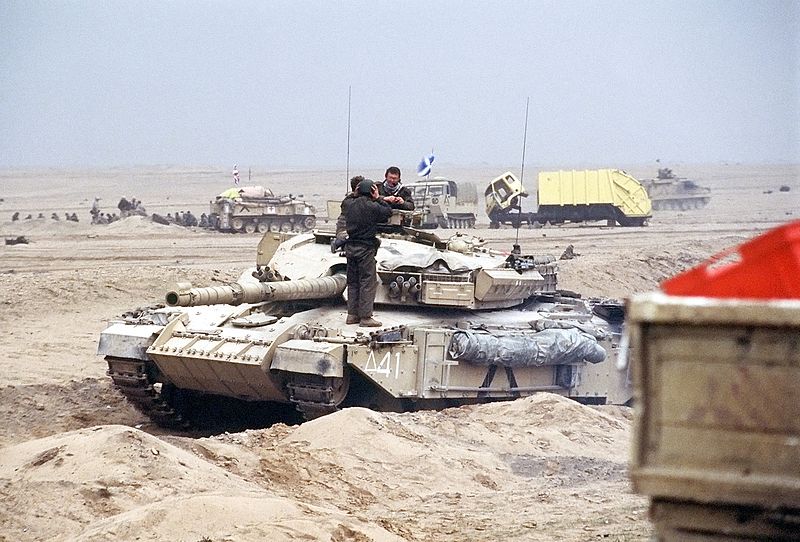 Operation Desert Storm. Challenger 1 mk.3 of the Royal Scots Dragon Guards. Notice the ERA blocks added on the glacis plates.
On 22 November 1990, the 4th Mechanized Brigade was also sent, under the 1st armoured division which also counted many Chieftains. This unit comprised the 14th/20th King's Hussars and a lifeguards squadron all with Challengers Mk.2. They received the Mk.3 modifications plus extra storage bins for the 120 mm. Under the the command of the US VII Corps, the British 1st Armoured Division was tasked to destroy the bulk of the Iraqi armoured divisions. As the easternmost unit in the whole VII Corps, this unit crossed through Kuwait and the Challengers spearheaded the 350 km/97 hours advance, destroying in the process Iraqi's 46th Mechanised Brigade, 52th Armoured Brigade part of three infantry divisions (7th Corps). They also captured or destroyed about 200 tanks and many APCs and armoured vehicles.
Operation Desert Storm. Challenger 1 mk.3 of the Royal Scots Dragon Guards. Notice the ERA blocks added on the glacis plates.
On 22 November 1990, the 4th Mechanized Brigade was also sent, under the 1st armoured division which also counted many Chieftains. This unit comprised the 14th/20th King's Hussars and a lifeguards squadron all with Challengers Mk.2. They received the Mk.3 modifications plus extra storage bins for the 120 mm. Under the the command of the US VII Corps, the British 1st Armoured Division was tasked to destroy the bulk of the Iraqi armoured divisions. As the easternmost unit in the whole VII Corps, this unit crossed through Kuwait and the Challengers spearheaded the 350 km/97 hours advance, destroying in the process Iraqi's 46th Mechanised Brigade, 52th Armoured Brigade part of three infantry divisions (7th Corps). They also captured or destroyed about 200 tanks and many APCs and armoured vehicles.
Bosnia-Herzegovina (1994)
Under IFOR, a number of Vickers Defence Systems Challenger 1 MBTs has been deployed to Bosnia for peace-keeping operations. In addition to Germany and UK, Challengers were also sent in Canada at the British Army Training Unit, Suffield. After their replacement, some ended in British museum collections, gate guards on UK bases, and at least one in a private owners collection in UK. This is quite a short life span in British service, however upgraded "Falcon" Jordanian Al Hussein are planned to stay in service at least until 2030.Sources/Links about the Chieftain
The Challenger I on Wikipedia On army-guide.Video (2008 Documentary)
Challenger I specifications

The Mihr/Shir 2 demonstrator intended for Iran, from which the Challenger will be derived.

Mk.3 with IFOR, Bosnia Herzegovina 1997.

Challenger 1 Mk.3, 1st Tank 2nd Troop, D squadron, King's Royal Hussars, KFOR Kosovo 1999. The upside down yellow triangle indicates that it belonged to D squadron, while the number 21 means it belonged to the Sergeant of the 2nd Troop. A member of the squadron indicates that the commander of this vehicle at the time was probably Pete Surridge.

Challenger 1 Mark 3, Sqdn.leader, D Squadron, Queens Dragoons Guards, Operation "Resolute" Bosnia 1996.

Mk.3 in the gulf war, 14th/20th King's Hussars

Mk.3 Gulf War, 7th Armoured brigade

Jordanian Al Hussein main battle tank, first batch, with a digital camouflage in the late 1990s.

Jordanian Al Hussein MBT in the 2000s
Gallery
Challenger1-IFOR_landing_Bosnia
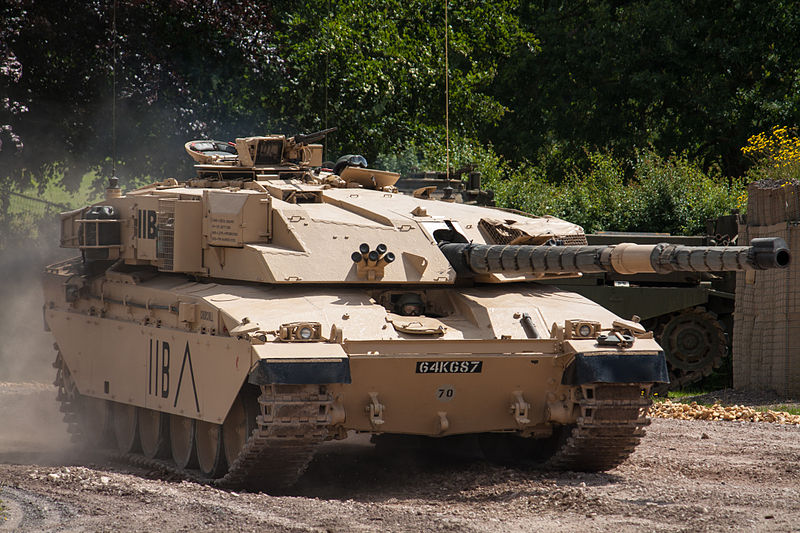
Challenger_1MBT_Mk_3
A_Challenger_1_tank_of_the_7th_Brigade_Royal_Scots_fullspeed
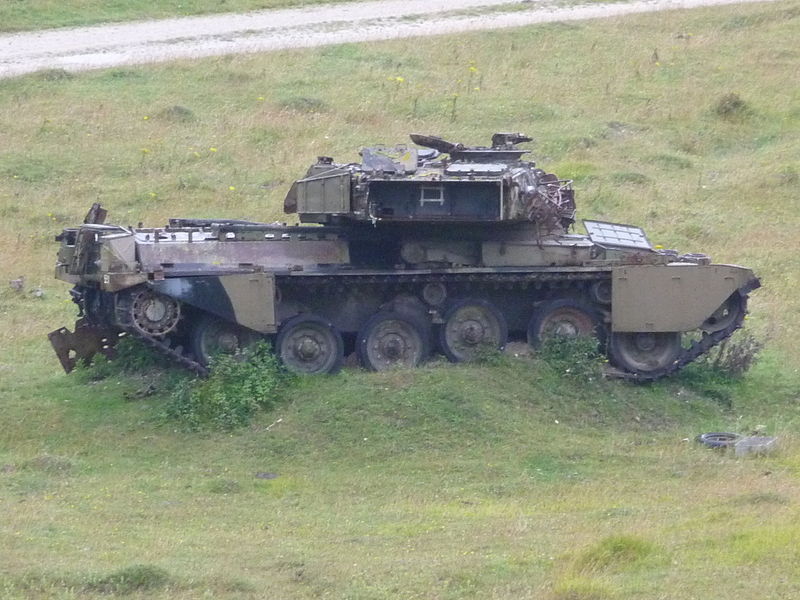
Challenger_2008_Tank_Firing_Range_Bovington
_Bonvington.jpg)
Challenger_Armoured_Repair_and_Recovery_Vehicle_(CRARRV)_Bonvington
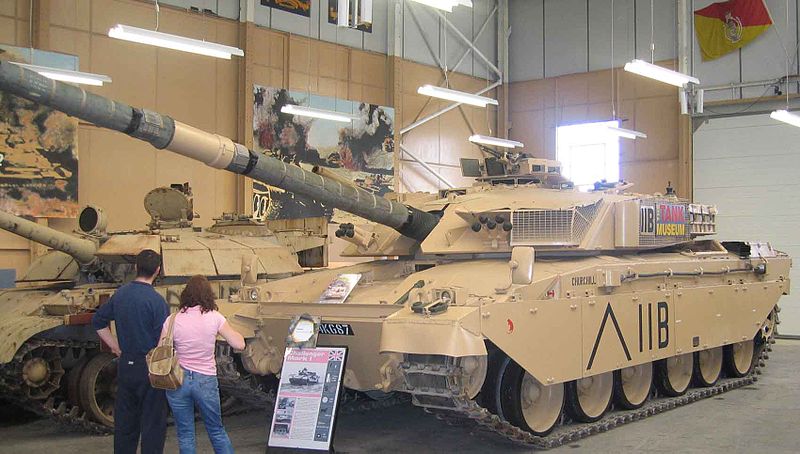
Challenger_I_Mk3_Bovington
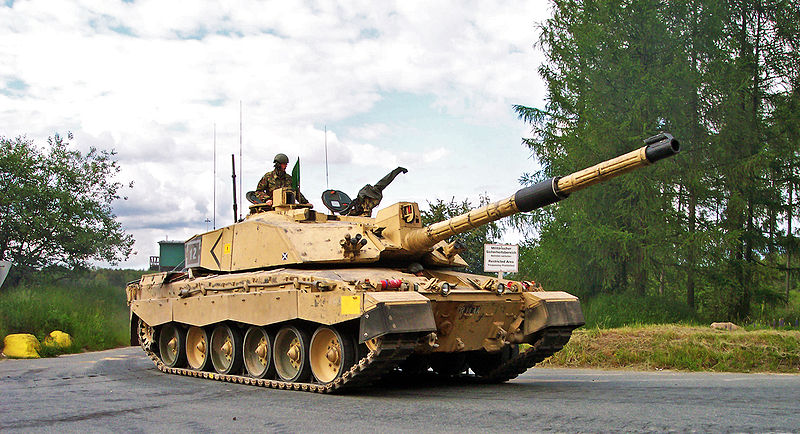
Challenger 2 at the winter Bergen Hohne training are. Despite exterior similarity and name, both tanks only share 5% of common parts

Cold War Tanks


































Cold war tanks posters

Cold War Main Battle Tanks

Cold War Soviet Army
Museums, Movies, Books & Games
The Tanks and Armor in pop culture
Tanks and armored vehicles in general are only really grasped when seen first person: The mass, the scale, it's all there. Explore also the way tanks were covered in the movie industry, in books and in video games.Movies:
Best tanks movie on warhistoryonline.com
On imdb.com
On bestsimilar.com/
miltours.com
liveabout.com/
watchmojo.com
Video Games:
pcgamesn.com
historyhit.com
levvvel.com
vg247.com/best-tank-games
mmobomb.com/
alienwarearena.com

